
Creative school plans could counter inequities exposed by COVID-19
DATE: September 9, 2020
The emergency pivot to remote learning for K–12 students last spring illuminated longstanding educational fault lines in the United States. The most vulnerable students — children with disabilities, English language learners and children from marginalized Black, Hispanic and Native American communities — were less likely than their affluent and mostly white peers to have basic necessities such as regular meals, a quiet place to work, computer access, guidance on how to get online and even online access itself.
Read the full article here.



